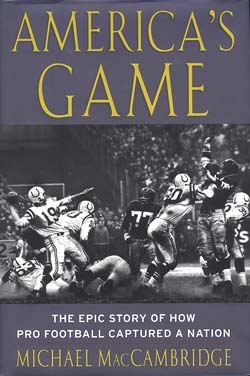(Random House, 2004)
On December 28, 1958, the NFL’s championship game pitted the Baltimore Colts against the New York Giants.
In a game that is firmly entrenched as one of the best championship games ever played, the Colts prevailed, 23-17, in overtime on Alan Ameche’s goal-line plunge.

In the nearly half-century since that epic battle, football in general — and the NFL more specifically — has risen from a mere afterthought in the sporting world to a place of prominence.
Indeed, many people think football is now the Sport of America, surpassing baseball, which has been around for nearly 150 years.
In his book America’s Game (published in 2004 with the paperback edition slated for an Oct. 1 release), Michael MacCambridge tracks the rise in popularity of the NFL since that title game in 1958.
“I realized that pro football had been America’s unquestioned most popular sport for more than a generation, yet I’d never read a good account of how it got to be that way, how it eclipsed baseball, the unchallenged ‘national pastime,’ as the nation’s favorite spectator sport,” said MacCambridge, adjunct professor in University College in Arts & Sciences, whose courses include “Intro to Mass Media” and “Sports, Media and Society.”
“That’s the story I set out to tell. I wrote the proposal in 1999 and the book was published in the fall of 2004, so it took me five years from start to finish.”
The reasons are numerous for the other sports’ dwindling popularity among Americans. Pick up any sports page and you’ll read stories about steroid use and escalating salaries in baseball; the lockout in hockey; and any one of a number of transgressions in the NBA.
But far from being the beneficiary of other sports’ problems, football also supplanted baseball by doing things the right way.
“Pro football has suffered fewer self-inflicted wounds than the other sports in the past decade, which is why its position at the top has solidified,” MacCambridge said. “But when it rose to the top, it was because the game was more exciting and a better reflection of the modern age than baseball, and because it was structured intelligently, under the egalitarian principle that every club, whether based in New York or Green Bay, should have a fair shot at competing.”
MacCambridge admits that baseball is ingrained in the national culture, and as such, at some level is “impervious to its bad publicity.”
But everything in life is cyclical, and while he doesn’t think that any of the current major sports will eclipse the popularity of football, MacCambridge could see another sport on the horizon giving the pig-skin a run for its money.
Soccer.
“(Right now), football is a more contemporary, more broadly popular and quite simply a better-run game,” he said. “I don’t think football will lose its primacy to the other major team sports of today.
“What I could see happening, maybe not in my lifetime but sometime in the distant future, is the changing demographic patterns in America, as well as the widespread popularity of little-league soccer, allowing the world’s most popular sport to become a major force in American popular culture.
“Whether it would ever challenge the NFL remains to be seen, but soccer is already becoming a presence on the American sporting landscape. Wait until you see the kind of coverage and following the U.S.A. enjoys in the 2006 World Cup.
“That, in many ways, could be the future of sports in America.”
MacCambridge’s most recent book, the ESPN College Football Encyclopedia, which he conceived of and edited, was released Sept. 1.
— Andy Clendennen